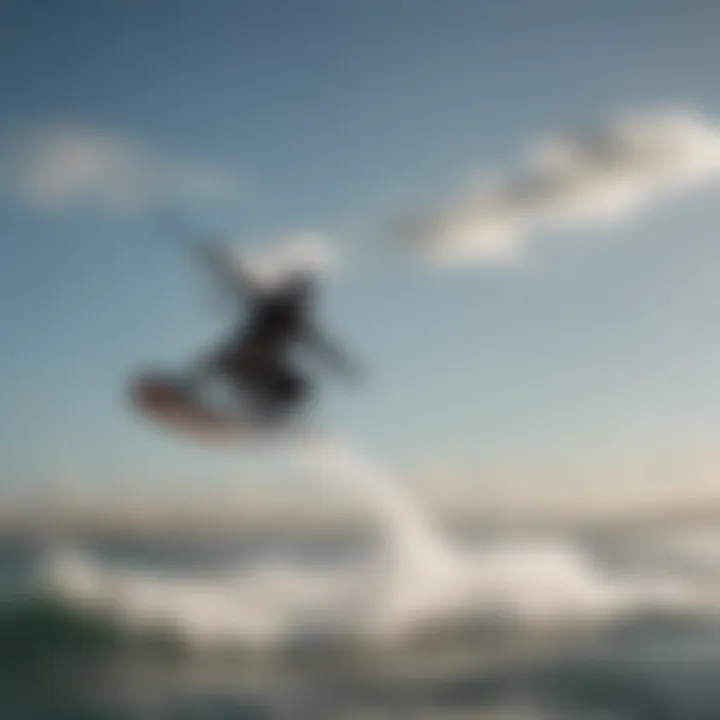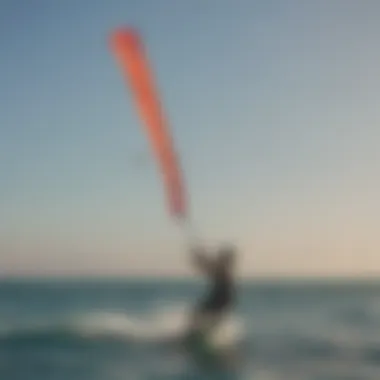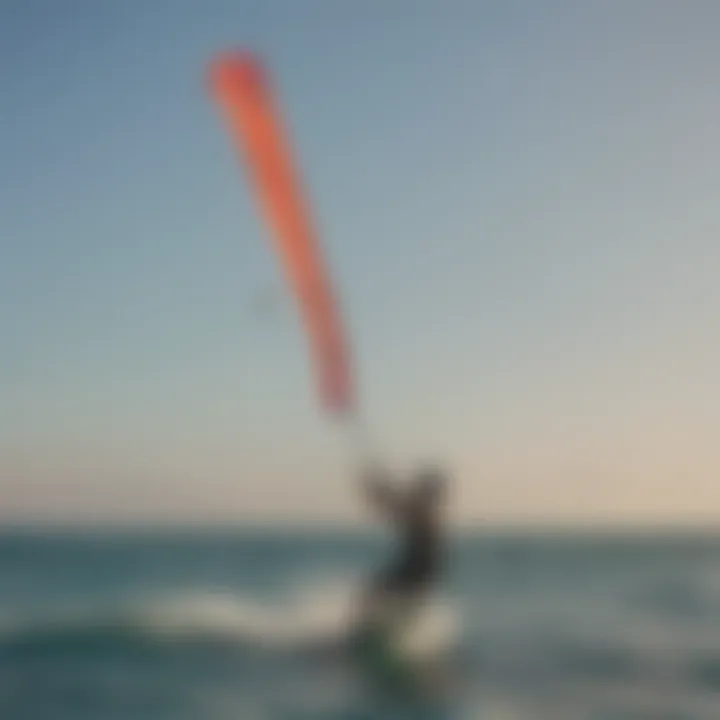In-Depth Exploration of Kiteboard Bars


Intro
Kiteboarding is a dynamic and exhilarating sport that relies heavily on the equipment used, with kiteboard bars being essential for maneuverability and control. As riders navigate varied water conditions and winds, understanding the role and intricacies of these bars becomes crucial. This guide aims to provide comprehensive insights into kiteboard bars and related equipment, ensuring that both novice and experienced kiteboarders can enhance their skills and enjoy their time on the water.
In this exploration, we will cover several key areas. We will discuss how kiteboard bars are designed and their functionality. Additionally, we will review specific types of equipment including kite models, boards, and essential accessories. Furthermore, we will address safety guidelines and maintenance tips critical for effective and safe kiteboarding. This synthesis of knowledge is aimed at elevating the kiteboarding experience, ensuring riders can make informed choices when selecting their gear, while also understanding the significance of maintaining it.
Understanding the Kiteboard Bar
Kiteboard bars are a central element in kiteboarding, significantly influencing how a rider engages with their kite. Understanding their role is crucial for both novice and experienced kitesurfers. This section will explore what kiteboard bars are, their primary purpose, and how their historical development has shaped modern designs.
Definition and Purpose
A kiteboard bar serves as the main control system that connects a kite to its rider. It allows the kitesurfer to steer the kite and control its power. The bar typically consists of a horizontal structure, often made from aluminum or carbon, with grip handles on either end.
Users manipulate the bar by pulling or pushing it. This action changes the angle of the kite against the wind, allowing riders to navigate effectively on the water. The key purposes of the kiteboard bar are:
- Lift and Control: The bar provides the ability to generate lift while also allowing the rider to steer the kite.
- Safety Mechanism: Modern bars include safety features that help disengage the kite from the rider in emergencies.
- Adjustable Performance: Features such as adjustable lines let riders customize settings to suit their style, skill level, or conditions of the water.
By mastering the kiteboard bar's function, riders can enhance their performance, ensuring a safer and more enjoyable experience on the water.
Historical Development
The evolution of kiteboard bars parallels advancements in kitesurfing technology and materials. In the early days, kiteboarding bars were simple and lacked many functionalities we see today. Early models often had basic structures and limited control systems. Instead of harnessing advanced materials, early designs were prone to failure, leading to safety concerns.
With the rise of kiteboarding in the late 1990s and early 2000s, innovations in design and materials became the norm. Key developments included the introduction of the chicken loop, which allowed for quick disconnects in case of a mishap. This added a crucial safety element that was missing in older designs.
Additionally, the materials used in manufacturing bars transitioned from metal to lightweight composites, making them more user-friendly and durable. The introduction of adjustable lines and the refinements in ergonomic grips have also contributed to the current high standards of kiteboard bars.
In sum, understanding the historical context of kiteboard bars highlights how crucial design elements have emerged to improve functionality and safety, ultimately enhancing the kitesurfing experience.
Components of a Kiteboard Bar
Understanding the components of a kiteboard bar is essential for any kiteboarding enthusiast. This section explores how each element of the bar works in concert to deliver control and responsiveness. Proper knowledge of these components enhances not only the safety of the rider but also the performance of the kite, making it a critical part of kitesurfing.
Main Bar Structure
The main bar is the core of any kiteboard setup. Typically constructed from lightweight materials like aluminum or composite, it serves as the user interface between the rider and the kite. The structure needs to be sturdy, as it bears the immense forces exerted by the kite during flight. Its length can vary depending on rider preferences and specific styles of kiteboarding. A longer bar allows for more noticeable input during turns, while a shorter bar can provide more control in aggressive maneuvers.
Additionally, the grip on the bar is crucial. Most bars feature ergonomic designs with textured surfaces to prevent slipping, ensuring a firm hold even in challenging conditions. Some advanced models may also incorporate quick-release systems, which facilitate fast disconnection from the kite in case of emergencies. This safety feature can be life-saving, making it a significant aspect of the main bar’s design.
Lines and Connections
Lines connect the bar to the kite, providing the primary means of control. High-quality lines are typically constructed from Dyneema or similar materials known for their strength and durability. These lines should be regularly inspected for wear and fraying, which can lead to catastrophic failures. The connections at the ends of these lines, such as the pigtails or flying lines, also play a vital role in the overall functionality of the bar.
The number of lines varies by kit, with most modern kites sporting either four or five lines. Four-line setups are more common for freestyle and freeride kiting, as they enhance maneuverability. In contrast, five-line systems provide additional stability and safety, particularly in gusty conditions. Understanding these differences is crucial when selecting equipment that aligns with individual riding styles.
Adjustable Features
Adjustability is another important element in kiteboard bars. Many bars come equipped with features allowing riders to modify the setup according to their skill level and specific riding conditions. For instance, adjustable trimming straps and depower settings enable riders to control how much power is generated by the kite with relative ease. This feature is particularly beneficial for beginners, as it can significantly enhance learning curves.
Moreover, some advanced bars offer adjustable width. This adaptability lets kiteboarders fine-tune their interactions with the kite based on preference or technique. Riders can set the bar wider for more control during tricks or closer together for faster responses during high-speed runs. With a thoughtful design, adjustable features positively contribute to rider comfort and performance.
"The right components and their arrangement in a kiteboard setup can amplify performance and elevate the overall kitesurfing experience."
In summary, the components of a kiteboard bar each have unique roles that significantly impact the overall functioning of the kiteboarding system. Knowing how the main bar structure, lines and connections, and adjustable features work together helps riders make informed choices that enhance both performance and safety.
Types of Kiteboard Bars
Understanding different types of kiteboard bars is essential for both safety and performance in kiteboarding. Each design serves distinct purposes, tailored to various riding styles and conditions. Choosing the right type can greatly enhance your experience on the water, ensuring better control and responsiveness. This section sheds light on the three primary types of kiteboard bars: freeride bars, wave bars, and foil bars, highlighting their specific features, advantages, and situational best uses.


Freeride Bars
Freeride bars are designed for versatility and ease of use. They suit a wide range of skill levels, making them a popular choice among recreational kiteboarders. These bars typically feature a straightforward setup with minimal adjustments, allowing riders to focus on their performance rather than technical complexities.
Key attributes of freeride bars include a comfortable grip and a smooth depower system. Many models also include safety release mechanisms for emergency situations. The wider stance of the lines provides better stability, making it easier to manage power during transitions and jumps. This stability is crucial for beginners learning to navigate the kite and those more experienced riders who enjoy performing tricks in various conditions.
Wave Bars
Wave bars are specifically tailored for kiteboarding in surf conditions. They offer enhanced responsiveness and allow for quick maneuvering, which is vital when riding waves. The design tends to be more compact than freeride bars. This design minimizes line slack, reducing the risk of tangling during practice.
A notable feature of wave bars is their ability to handle gusty winds and powerful waves. The ability to maintain control during these unpredictable conditions enables riders to focus on their technique. Additionally, wave bars often come with option for adjustability, allowing athletes to fine-tune their setup according to personal style and environmental conditions.
Foil Bars
Foil bars cater to kiteboarders interested in riding foils. These bars are distinct in their design; they often have a shorter and narrower profile. The reduced surface area allows for quicker and more precise handling, which is essential when controlling a foil.
The lines on foil bars are usually configured for lower drag. This feature is crucial, as the aim is to minimize resistance, allowing the foil to lift smoothly above the water's surface. Foil bars often include unique adjustments for kite height and power control to ensure an optimal riding experience, particularly in light wind conditions.
Choosing the right kiteboard bar type is fundamental for maximizing your performance and enjoyment while kiteboarding.
In summary, selecting among freeride, wave, and foil bars largely depends on individual riding styles and preferences. Freeride bars offer a general-purpose solution, wave bars excel in surf conditions, and foil bars are tailored for specific foil riding. Knowledge of these types will equip riders to make informed decisions, thus enhancing their kiteboarding adventures.
Choosing the Right Kiteboard Bar
Selecting the appropriate kiteboard bar is a decisive factor that can shape both the performance and safety of a kiteboarder. The right bar affects how an individual controls their kite, manages the power, and responds to the wind conditions. A mismatch between the bar and rider can lead to ineffective handling, which may result in a less enjoyable experience or even accidents. This subsection emphasizes the importance of understanding various elements when choosing a kiteboard bar, ensuring the optimal setup for performance and safety.
Factors to Consider
When choosing a kiteboard bar, there are several key factors that need to be carefully considered:
- Bar Length: The length of the bar is crucial as it affects the amount of control a rider has over the kite. Longer bars may provide increased maneuverability, while shorter ones could lend more precise control and quicker response times.
- Line Length: Kiteboard bars typically come with lines of varying lengths. Shorter lines may be better for more experienced riders who desire tighter handling, whereas longer lines can benefit beginners by allowing a safer distance from the kite.
- Grip and Comfort: A bar's grip is vital for preventing slippage during water sports. Look for options with ergonomic designs that minimize fatigue during long sessions. Adjustability can also be an important consideration to find a right fit for personal comfort.
- Safety Features: Safety should never be compromised. Examine the safety release mechanism, whether it is easy to activate in emergencies. A bar equipped with an effective depower system is preferable to enhance rider control during sudden changes in wind conditions.
- Weight and Material: The weight of a bar affects how well it performs in various wind conditions. Lightweight materials can facilitate better maneuverability, while sturdier builds often translate to durability.
Overall, matching a kiteboard bar's features to a rider's skill level and preferred riding style is essential.
Compatibility with Kites
Compatibility between a kiteboard bar and the kite is a significant consideration. Not every bar will work effectively with every kite, so understanding this relationship is paramount. A bar designed for freestyle kites may not perform well with wave kites or foil kites.
When assessing compatibility, consider the following:
- Connection Systems: Different kites have varying connection systems. Ensure the kiteboard bar you choose features the correct attachment mechanism suited for your specific kite model.
- Adjustable Options: Some bars come with adjustable features that allow for compatibility with multiple kite brands or models. This flexibility can be beneficial for those who switch out kites regularly.
- Control Systems: Certain kites may require unique control reactions from the bar. Make sure the bar can accommodate the way your kite is designed to behave under different conditions.
By giving careful thought to these factors, kiteboarders can ensure that they select a bar that matches their kite and their riding style, ultimately enhancing their experience on the water.
"Choosing the right kiteboard bar not only improves your performance but also significantly enhances safety on the water."
Evaluating the elements of kiteboard bars and ensuring compatibility with kites sets the stage for a more enjoyable and safer kiteboarding experience.
Installation and Setup
Proper installation and setup of your kiteboard bar is not just a procedural chore; it is an essential step that impacts your safety and performance on the water. Correct assembly ensures that all components work harmoniously together, allowing for responsive control during kiteboarding sessions. Neglecting this aspect can lead to equipment mishaps or, worse, accidents that compromise rider safety. Knowing the specific steps in installation and setup will improve your overall experience with kiteboard bars.
Preparing the Lines
When preparing the lines, the initial step is to inspect each line for wear or damage. A damaged line can significantly impact performance, leading to unpredictable kite behavior. Ensure that lines are tangle-free and are laid out in their proper orientation. Organize lines systematically: front lines should be separate from rear lines. Cleanliness is also key; remove any sand or debris that could create friction or wear over time. As you prepare the lines, make sure to match their lengths carefully. Uneven lengths will lead to uneven pull and can cause difficulties in steering.
Attaching to the Kite
Attaching the bar to the kite requires attention to detail. Begin by locating the attachment points on the kite. These points are usually marked and correspond to specific lines. Securely fasten the front lines to the kite first, ensuring that the connections are tight and secure. Next, attach the rear lines, making sure there is no twisting or tangling. A straight connection offers better balance. Double-check the attachment points for any signs of damage. Use a knot that is recommended for this purpose, typically a double knot, to add extra security. This connection is crucial since any failure here could result in loss of control of the kite.
Final Adjustments


Final adjustments are necessary for optimal performance. Start by adjusting the length of the rear lines to achieve desired responsiveness. Test different settings while on the water, finding the equilibrium that suits your style. The bar width may also need adjustment; a wider bar can provide better control for specific styles, while a narrower setup might be suitable for others. Additionally, consider the trim settings on the bar. Adjusting the trim allows you to find balance and manage the kite's pull effectively. Regularly re-evaluate these settings, especially when switching conditions or different kites. Finding the right setup can enhance your kitesurfing experience and contribute to better performance.
"Proper installation is the foundation of a safe and enjoyable kiteboarding experience."
Taking the time to thoroughly set up your kiteboard bar enhances control, stability, and overall satisfaction during your kitesurfing experience. Prioritize these steps to ensure a safe and fun outing on the water.
Techniques for Effective Use
Effective use of kiteboard bars is crucial for optimal performance and safety in kiteboarding. Understanding specific techniques enhances control over the kite, making every session on the water more enjoyable and effective. With the right skills, kiteboarders can navigate various conditions and execute maneuvers with greater precision.
Steering and Control
Steering is a fundamental aspect of kiteboarding, directly affecting the rider's ability to navigate the water and respond to changing wind conditions. A well-tuned kiteboard bar provides the necessary feedback for steering. Riders need to grasp how to apply pressure effectively in either direction.
Learning to use both hands equally is essential. Mastery of using the back hand for steering, while keeping the front hand steady, helps in maintaining direction. This balance between hands contributes to smooth turns and transitions.
Also, riders should be aware of the kite's response relative to bar movements. Small inputs can lead to significant changes, especially in high winds. Oversteering can cause erratic kite behavior and may lead to potential accidents. Therefore, practice is key. Riders should focus on subtle movements to refine their ability to steer the kite more precisely.
Pressure Distribution
Pressure distribution is another critical factor that affects performance on the water. Understanding how weight shifts impact the kite's flight can make a big difference. Riders must know how to shift their body weight to maintain optimal pressure in the lines. This balancing act helps keep the kite flying at the indicated angle, which can enhance lift and control.
To manage pressure effectively, body positioning plays a significant role. Bending the knees and leaning into the turn allows for more stable control. Riders should also pay attention to the harness setup. An improperly adjusted harness can lead to uneven pressure distribution, impacting overall control.
When riding in different conditions, such as choppy water or strong winds, adapting pressure distribution can create a smoother experience. Maintaining constant awareness of how pressure affects the kite enhances overall performance.
"Effective pressure management enables kiteboarders to harness the wind's power efficiently, translating it into performance on the water."
In summary, mastering steering and pressure distribution techniques allows kiteboarders to optimize their experiences and increase safety. Continuous practice, awareness, and adjustments according to riding conditions are essential for every kiteboarder.
Maintenance of Kiteboard Bars
The maintenance of kiteboard bars plays a crucial role in sustaining their functionality and ensuring rider safety. Kiteboarding is an extreme sport that exposes equipment to harsh conditions, including saltwater, sand, and varying weather. Proper care not only extends the lifespan of the bar but also enhances performance on the water. Riders should prioritize maintenance to avoid equipment failure that can lead to accidents.
Regular Inspections
Conducting regular inspections is essential for kiteboard bar maintenance. Riders should routinely check components such as the main bar structure, lines, and connections. Here are key points to consider during inspections:
- Visual checks: Examine the bar for signs of wear, including cracks, fraying lines, or damaged connections.
- Check knot integrity: Ensure that knots are secure and not showing signs of degradation. A loose or weak knot can lead to line failure.
- Inspect safety systems: Make sure all safety features operate correctly. Check for any wear on the quick-release mechanisms, as they are critical during emergencies.
Regular inspections should occur before and after each session. This proactive approach helps identify potential issues early, allowing for timely repairs.
Cleaning Procedures
Cleaning kiteboard bars is vital to remove salt, sand, and debris that can accumulate over time. This buildup can cause gradual damage if left unattended. Here are some cleaning procedures that riders should adopt:
- Rinse with fresh water: After each session, rinse the bar thoroughly to eliminate saltwater that can corrode metal components. Ensure to remove all sand as well.
- Use mild soap: Occasionally, use a mild soap to clean stubborn dirt or grime. Avoid harsh chemicals that can damage the materials.
- Dry properly: After rinsing, allow the bar to dry completely in a shaded area. Sunlight can degrade materials over time.
Regular maintenance, including inspections and cleaning, not only enhances safety but also optimizes performance on the water.
By adhering to these practices, riders can maintain the integrity of their kiteboard bars, ultimately improving their kiteboarding experience. Properly maintained equipment reveals its potential and supports an effective and enjoyable ride.
Safety Considerations
Understanding safety in kiteboarding is paramount to enjoying the sport while minimizing risks. Kiteboarding can provide thrill and excitement, yet it also comes with inherent dangers. The importance of safety considerations cannot be overstated. Riders must be aware of the potential hazards associated with kiteboard bars and utilize best practices to enhance their safety.
Understanding Risks
Risks in kiteboarding are numerous and multifaceted. The dynamic nature of wind and water introduces unpredictability. Kiteboard bars, being the primary interface between the rider and the kite, can compound these risks if not handled correctly. Common risks include:


- Accidental Releases: A sudden release of the kite can lead to serious accidents.
- Line Entanglement: Loose lines can tangle, posing risks to the rider's safety.
- Improper Use: Failing to understand the bar setup may result in lack of control during maneuvers.
Being aware of these scenarios helps riders prepare and act effectively. Engaging with information about safety gear and understanding kite dynamics can mitigate these risks.
Best Practices for Safety
Implementing best practices is essential for reducing risks. Here are effective strategies:
- Pre-ride Checks: Always inspect your gear before heading out. Check the kite, bar, and lines for wear or damage.
- Practice Proper Set-Up: Ensure lines are attached correctly and are free of knots.
- Stay Educated: Continuously improve your skills through lessons and discussions with more experienced riders.
- Use Safety Features: Always activate the safety release system on the bar during use.
"Safety first is safety always."
This quote encapsulates the commitment a rider must have when participating in kiteboarding. Following these best practices can significantly enhance your safety on the water.
Common Issues and Solutions
Every equipment has its challenges, and kiteboard bars are no exception. Understanding common issues that may arise during use can help riders address problems quickly and safely. This knowledge leads to improved performance and enhances overall enjoyment in kiteboarding. Here, we will explore two crucial areas of concern: line wear and tear and handling malfunctions. Each section presents insights valuable to both novices and seasoned riders.
Line Wear and Tear
Line wear and tear is a significant issue for kiteboarders. The lines are essential to the performance and control of the kite. Over time, they can degrade due to environmental exposure, friction, and regular use. A few telltale signs of line wear include fraying, discoloration, or inconsistent stiffness.
Addressing line wear requires regular inspection. Inspect the lines before and after each session. Look for any visible damage, like nicks or broken threads. If any issues are found, it may be time to consider replacements.
Benefits of Regular Inspections:
- Safety: Reducing the risk of line failure during use.
- Performance: Maintaining kite control for better ride quality.
- Cost-Effectiveness: Preventing more serious damage leads to savings in the long run.
Maintaining the kite lines also involves proper storage. Avoid folding lines in ways that create tight bends. Store them in a cool, dry place to mitigate further deterioration.
Handling Malfunctions
Malfunctions can disrupt kiteboarding experiences and can be caused by various factors. From incorrect line configuration to faulty components, identifying and correcting issues quickly is paramount. Understanding how to analyze and troubleshoot these problems is essential for any kiteboarder.
First, familiarize yourself with the components of your kiteboard bar. Know how each piece works together, and practice identifying parts that may not function properly. For example, if the depower strap is sticking, inspect it for sand or debris that may be causing the issue.
Here are some common problems and their solutions:
- Stiff or Sticky Depower Strap: Clean with fresh water and check for damage.
- Unresponsive Steering Lines: Check for knots or twists; ensure connections are secure.
Having basic tools on hand can also help in case of emergencies. A small toolkit including scissors, a multi-tool, and spare lines can aid in swift repairs.
"Preparation is key in kiteboarding. Knowing how to troubleshoot issues can save time and ensure a safer ride."
In summary, understanding common issues and their solutions is crucial for maintaining kiteboard bars and ensuring safety on the water. Regular inspections can prevent many problems stemming from line wear, while knowledge of handling, and addressing malfunctions will lead to a more enjoyable kiteboarding experience.
The Future of Kiteboard Bars
The future of kiteboard bars is an evolving topic that holds significant relevance for kitesurfers and extreme athletes. As the sport develops, so too do the components that enhance it, especially the kiteboard bar. Innovation in design and technology, along with a growing awareness of environmental impacts, are shaping what is to come.
Technological Innovations
Innovation in kiteboard bars encompasses various aspects, from materials to enhanced functionalities. Manufacturers are investing in research and development to introduce lighter, stronger materials, such as carbon fiber or advanced composites. These innovations not only improve performance but also increase the longevity of the equipment.
Another area of focus is the integration of smart technology. Sensors might be added to measure metrics like line tension, bar angle, and speed. Such data could inform athletes about their performance, allowing for more precise adjustments in technique and setup.
Furthermore, adaptability is a key theme. Bars that can easily change their settings for different wind conditions or rider preferences are gaining traction. More brands are introducing modular components, allowing for custom setups that cater to individual styles.
"Innovation is vital to maintain relevance in extreme sports. Kiteboard bars will likely lead the charge in this regard."
Sustainability Trends
Sustainability is becoming an essential consideration in the production of kiteboard bars. The kiteboarding community increasingly values eco-friendly practices. Manufacturers are responding by incorporating recycled materials into their products and minimizing waste in production processes.
The use of biodegradable materials is another trend, aiming to reduce the environmental footprint of the sport. Kiteboarders are encouraged to consider the lifecycle of their equipment, promoting recycling or upcycling, which aligns with broader sustainability goals.
Additionally, the push for sustainability is affecting brand practices. Companies are increasingly transparent about their environmental impact, leading to more informed consumer choices. Riders are showing preference for brands that demonstrate commitment to eco-friendly initiatives.







